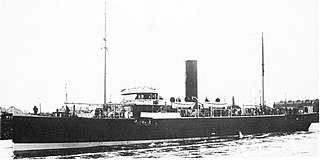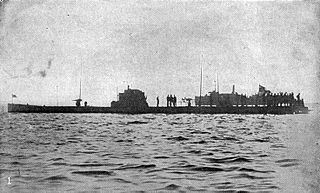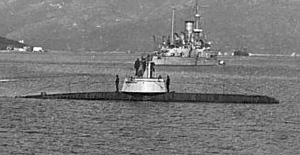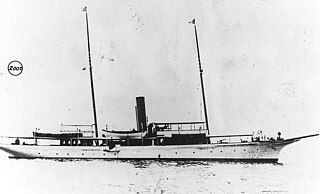
Q-ships, also known as Q-boats, decoy vessels, special service ships, or mystery ships, were heavily armed merchant ships with concealed weaponry, designed to lure submarines into making surface attacks. This gave Q-ships the chance to open fire and sink them. The use of Q-ships contributed to the abandonment of cruiser rules restricting attacks on unarmed merchant ships and to the shift to unrestricted submarine warfare in the 20th century.

USS Isabel (SP-521), later PY-10, was a yacht in commission in the United States Navy as a destroyer from 1917 to 1920 and as a patrol yacht from 1921 to 1946.

USS Kanawha II (SP-130)/USS Piqua (SP-130) -- was a yacht acquired by the U.S. Navy during World War I. She was placed into service as an escort for Allied convoys traveling across the dangerous North Atlantic Ocean. German U-boats were active in sinking Allied ships, and Kanawha II provided a valuable service as a lookout and in one instance attacked one and drove it off. Post-war she was returned to her pre-war owner in July 1919.

An armed yacht was a yacht that was armed with weapons and was typically in the service of a navy. The word "yacht" was originally applied to small, fast and agile naval vessels suited to piracy and to employment by navies and coast guards against smugglers and pirates. Vessels of this type were adapted to racing by wealthy owners. The origin of civilian yachts as naval vessels, with their speed and maneuverability, made them useful for adaptation to their original function as patrol vessels. In the United States Navy armed yachts were typically private yachts expropriated for government use in times of war. Armed yachts served as patrol vessels during the Spanish–American War and the World Wars. In the latter conflicts, armed yachts were used as patrol vessels, convoy escorts, and in anti-submarine duties. In the United States, yachts were purchased from their owners with the owners given an option to repurchase their yacht at the close of hostilities.

USS Lydonia (SP-700) was United States Navy patrol vessel in commission from 1917 to 1919 that saw service during World War I. Prior to her U.S. Navy service, she had been William A. Lydon's private yacht, Lydonia II, from 1912 to 1917. She spent most of the war based at Gibraltar, escorting and protecting Allied ships in the Mediterranean and along the Atlantic Ocean coast of Europe. After her U.S. Navy service ended, she served from 1919 to 1947 in the United States Coast and Geodetic Survey as the coastal survey ship USCGS Lydonia (CS-302).

SM U-53 was one of the six Type U 51 U-boats of the Imperial German Navy during the First World War.

The Mediterranean U-boat Campaign in the Mediterranean Sea was fought by Austria-Hungary and German Empire against the Allies during World War I. It was characterised by the ability of the Central Powers to raid with near impunity during the first years of the war, causing substantial shipping losses, until the introduction of the convoy system allowed the Allies to drastically cut their losses from 1917 on.
SM UB-47 was a Type UB II submarine or U-boat for the German Imperial Navy during World War I. UB-47 was sold to the Austro-Hungarian Navy during the war. In Austro-Hungarian service the B was dropped from her name and she was known as SM U-47 or U-XLVII as a member of the Austro-Hungarian U-43 class.

SM UB-10 was a German Type UB I submarine or U-boat in the German Imperial Navy during World War I.
SM UB-13 was a German Type UB I submarine or U-boat in the German Imperial Navy during World War I. The submarine was probably sunk by a British mine net in April 1916.
His Majesty's or HM Armed Smack Inverlyon was a fishing smack that was converted to a Q-ship during the First World War. Q-ships served as decoys to lure German submarines near enough so that concealed weapons could be brought to bear and sink the submarines. On 15 August 1915, Inverlyon succeeded in luring German submarine UB-4 within range and sinking her with nine shots from her gun. The Royal Navy Gunner in command of the vessel, Ernest Martin Jehan, received the Distinguished Service Cross and members of Inverlyon's crew shared the bounty offered for German submarines. After Inverlyon's Q-ship career ended, she returned to fishing, but was sunk by U-55 on 1 February 1917.

The U-boat Campaign from 1914 to 1918 was the World War I naval campaign fought by German U-boats against the trade routes of the Allies. It took place largely in the seas around the British Isles and in the Mediterranean. The German Empire relied on imports for food and domestic food production and the United Kingdom relied heavily on imports to feed its population, and both required raw materials to supply their war industry; the powers aimed, therefore, to blockade one another. The British had the Royal Navy which was superior in numbers and could operate on most of the world's oceans because of the British Empire, whereas the Imperial German Navy surface fleet was mainly restricted to the German Bight, and used commerce raiders and unrestricted submarine warfare to operate elsewhere.

The action of 5 September 1918 was a naval battle 200 mi off the coast of France in the North Atlantic during World War I. The action was fought between a German U-boat and American warships.

The action of 21 May 1918 was a naval engagement of World War I fought between an American armed yacht and a German submarine in the Atlantic Ocean off Spain.

The action of 18 June 1918 was an attack on two allied ships near Bermuda in the Atlantic Ocean by an Imperial German Navy U-boat during World War I. Sinking an allied merchant vessel, the American warship failed to destroy the U-boat.
The Torpedo Alley, or Torpedo Junction, off North Carolina, is one of the graveyards of the Atlantic Ocean, named for the high number of attacks on Allied shipping by German U-boats in World War II. Almost 400 ships were sunk, mostly during the Second Happy Time in 1942, and over 5,000 people were killed, many of whom were civilians and merchant marines. Torpedo Alley encompassed the area surrounding the Outer Banks, including Cape Lookout and Cape Hatteras.

United States Navy operations during World War I began on April 6, 1917, after the formal declaration of war on the German Empire. The American navy focused on countering enemy U-boats in the Atlantic Ocean and the Mediterranean Sea, while convoying men and supplies to France and Italy. Because of United States' late entry into the war, her capital ships never engaged the German fleet, and few decisive submarine actions occurred.

USS Venetia (SP-431) was a large 589 gross ton steam yacht leased by the U.S. Navy during World War I. She was heavily armed with four 3-inch (76 mm) guns and depth charges, and was assigned duties of a patrol craft, escorting ships in convoy on the North Atlantic Ocean, and protecting those ships from German submarine attack. Venetia was awarded a "star of reward" for her antisubmarine work, and mounted the star on her stack. Post-war she was restored to her original civilian configuration, and was returned to her owner.

The action of 15 February 1918 was a naval engagement which occurred during the First World War. The action was fought between an Imperial German destroyer squadron and the lightly armed ships of the Dover Patrol in the Strait of Dover, English Channel.

















